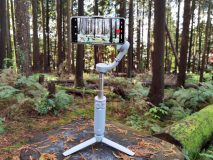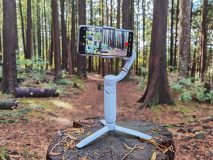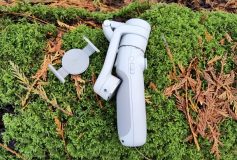
These days, everybody is a content creator. Wherever you go, people are taking photos and videos on their smartphones and sharing it on social media for all to see. In that respect, the smartphone has proven to be a versatile tool for a quick and easy way to create content. The cameras are improving with built-in AI features that sense your surroundings and auto-adjust the exposure, white balance, and brightness.
Many—myself included—prefer taking photos and videos on a smartphone rather than a DSLR. With the right camera and camcorder accessories, creators can create professional-looking content with their mobile devices.
I’m reviewing the DJI Osmo Mobile 5 smartphone gimbal stabilizer. It’s super portable. It also comes with a built-in extension rod, and features instructional videos to help you get the most out of it. If you want to create smoother videos using your smartphone, this review is for you.
Design of the DJI OM5
The DJI Osmo 5 has a couple of new design features that particularly appeal to vloggers. First, it’s lightweight and portable. It folds down and easily fits into a purse, backpack, or camera bag—it’s almost small enough to fit into a pocket. Second, it has an extension rod, which is commonly known as a selfie stick. With the front-facing camera, users can walk and record smooth videos in both portrait and landscape orientation. A tripod is also included that can be screwed onto the bottom to position the gimbal on a flat surface.
The DJI OM5 comes with a magnetic clamp that attaches to the smartphone. This should be compatible with most phones. It’s important to strategically place the clamp in the centre of the phone. A small groove on the top gives room for buttons. This is super important as the button sometimes gets in the way of proper placement. Once the clamp is attached, it magnetically connects to the gimbal. The magnetic connection is super strong, so there’s no worry that it will fall off.
DJI OM5 control options
On the front of the DJI OM5 is the joystick, record, and rotate button. The joystick allows users to move the gimbal up, down, left and right. Pressing the rotate button once switches between front and rear cameras. Pressing it twice changes the orientation from vertical to landscape. This is very easy to do on the fly.
To the left of the joystick is the power and digital zoom slider. The zoom slider only works inside the DJI Mimo app. Pressing the power button switches between photo and video modes.
The buttons are designed for right-handed use. While they are accessible and intuitive, as a leftie, I was unable to access the power button and zoom slider with my fingers. Instead, I had to use my thumb which I found both awkward and ineffective.
Using the DJI OM5 to film videos
Setting up the DJI Osmo 5 was quick and easy. It takes a little time to get used to the folding mechanism, but I really appreciate the compact design. The DJI app provides a basic overview on how to use the OM5 which I found helpful.
The gimbal does a fantastic job of keeping steady and smooth videos. As I walked through a local trail, the footage looked stellar. The three-axis stabilization does a good job compensating for hand movements. Being left-handed, I tried to use it with my right hand but it did not feel natural. With my left-hand, I barely used the digital zoom because I could not access it. Instead, I spent a lot of time using the joystick with my left thumb.
At the default speed, the joystick movements were choppy. It was difficult to get a nice smooth move. Thankfully, the speed of both the digital zoom and joystick can be adjusted inside the Mimo app. Personally, I found the default settings to be too fast. Hopefully they can change or improve it in a later update.
ShotGuides and ActiveTrack 4.0
The DJI OM5 provides users with a lot of filming options. Gimbal newbies may not be familiar with all different filming styles. ShotGuides educate and instruct users through different video examples, which I think can help a lot of people who are still learning about filming improve their style. As you shoot a video, the Mimo app recognizes the scenario and a popup ShotGuide window will appear with different demo shots.
By selecting a demo shot, the app will automatically adjust parameters and provide guidance for camera movement and speed. After shooting 6 clips, tap the video generation icon, and DJI Mimo will automatically create a video for you.
ActiveTrack 4.0 is simple to set up and use. This feature follows a subject or object and keeps it in frame. Combined with the tripod attachment and extension rod, this turns the gimbal into a robotic cameraman. During filming, a subject can move around and the DJI OM5 will follow them. Activating ActiveTrack 4.0 is simple. Simply draw a square around the object with your finger on the screen, and it will start tracking.
Final thoughts on the DJI OM5
There are no shortages of smartphone stabilizers on the market today. The one you ultimately pick depends on your needs, preferences, and experience. DJ OM5 is a compact, portable gimbal that’s light and easy-to-use. It’s perfect for both beginners and intermediates.
The addition of an extending pole makes it a great choice for vloggers. This is especially useful for people who use the front-facing camera a lot. ActiveTrack 4 is easy to operate and works best with the tripod attachment and extension pole. It’s a quick and effective way to film and keep yourself in frame as you move around. With enough experience and the right smartphone, anyone can shoot creative videos. The DJI Mimo App provides a ton of resources to help users get the most out of it.
That said, there is room for improvement. First, I would like to see additional buttons for left-hand users. I don’t see why they couldn’t put additional power and zoom slider buttons on the right side. Without it, left-handers can’t access any zoom control. This limits the use and creative potential of this gimbal. Users should be able to choose what hand they intend to use inside the DJI Mimo app. Second, I would like to see improvements in the joystick control. Even at the slow level, it’s hard to get a nice, smooth shot with the joystick. Instead, I found it better to manually move my hand rather than using it.
If you’re a vlogger, right-handed, and looking to create smoother videos, I highly recommend you give the DJI OM5 a look.






